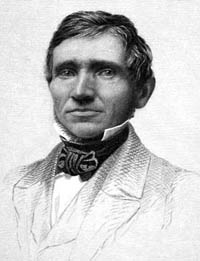Question from Mary B.:
When was the safety pin invented? Was it patented?
-Mary
Great question, Mary!
Walter Hunt received US patent #6,281 on April 10, 1849 for a Dress-Pin.
Interestingly enough, Hunt only invented the safety pin to pay off a debt. He had be fiddling with some wire trying to think of a new idea when he made the safety pin. The first pin was an eight-inch piece of brass wire, coiled at the center.
He sold the patent rights for four hundred dollars to pay off his debt, then spent the rest of his life watching others profit from his idea.
The safety pin was one of a few useful objects Hunt patented. His other inventions included a flax spinner, a street car bell, a knife sharpener and a sewing machine. Unfortunately, as well as any of them worked, Hunt never turned much of a profit for himself.
Ask the Geek, Get a Free Patent Mug
That’s right, if your question is chosen to be featured in our weekly “Invention Geek” column, we’ll send you a free one-of-a-kind patent mug custom pressed with a picture from your invention and the title of Honorary Invention Geek.
Got a pressing question about innovation history? Jump over to Ask the Invention Geek for details & an easy entry form!


 Charles Goodyear despite having no money, no knowledge of chemistry and only the crudest of tools, spent years experimenting with rubber. Prior to starting his experiments with rubber, Goodyear had a hardware business which went bankrupt. That was the beginning of many disastrous business attempts undergone by Goodyear. His first foray into inventing rubber products was not actually for rubber. Instead he invented a valve for inflating rubber life preservers. In 1834, he tried to sell his design to the Roxbury India Rubber Company in New York City. But on his visit there, he discovered that Roxbury India Rubber Company was on the verge of failing. Customers were returning life preservers because they were melting in the heat. The business was so bad and the failure such an embarrassment that a pit had been dug to bury failed products. The valve needed improving but the rubber was worse.
Charles Goodyear despite having no money, no knowledge of chemistry and only the crudest of tools, spent years experimenting with rubber. Prior to starting his experiments with rubber, Goodyear had a hardware business which went bankrupt. That was the beginning of many disastrous business attempts undergone by Goodyear. His first foray into inventing rubber products was not actually for rubber. Instead he invented a valve for inflating rubber life preservers. In 1834, he tried to sell his design to the Roxbury India Rubber Company in New York City. But on his visit there, he discovered that Roxbury India Rubber Company was on the verge of failing. Customers were returning life preservers because they were melting in the heat. The business was so bad and the failure such an embarrassment that a pit had been dug to bury failed products. The valve needed improving but the rubber was worse.  The first upright vacuum cleaner was invented by a janitor in Canton, Ohio. James Spangler was extremely prone to allergies and he was sure that his cough and asthma attacks were caused by the carpet sweeper he used at work. To alleviate this problem, he created a very basic suction sweeper. His device was just a box fan, a broom handle, a tin soap box and pillow case to collect dust. Despite being primitive and hard to use, the device did actually work. Spangler’s cough and asthma attacks lessened. Spangler continued to refine his “suction sweeper” and eventually applied for a patent. On June 2, 1908, he received US Patent Number 889,823 for a Carpet Sweeper and Cleaner.
The first upright vacuum cleaner was invented by a janitor in Canton, Ohio. James Spangler was extremely prone to allergies and he was sure that his cough and asthma attacks were caused by the carpet sweeper he used at work. To alleviate this problem, he created a very basic suction sweeper. His device was just a box fan, a broom handle, a tin soap box and pillow case to collect dust. Despite being primitive and hard to use, the device did actually work. Spangler’s cough and asthma attacks lessened. Spangler continued to refine his “suction sweeper” and eventually applied for a patent. On June 2, 1908, he received US Patent Number 889,823 for a Carpet Sweeper and Cleaner. The yellow circle with eyes and a smile that can be seen almost everywhere was designed by a freelance artist for State Mutual Life Assurance in 1963. The company had merged with another insurance company and employee morale was low. In order to improve feelings among the employees, Harvey Ball was asked to create a smiley face to be used on company buttons, letterheads and posters.
The yellow circle with eyes and a smile that can be seen almost everywhere was designed by a freelance artist for State Mutual Life Assurance in 1963. The company had merged with another insurance company and employee morale was low. In order to improve feelings among the employees, Harvey Ball was asked to create a smiley face to be used on company buttons, letterheads and posters. Earl S. Tupper envisioned himself a modern day Leonardo da Vinci. He was always dreaming up new inventions. He filled notebooks with his ideas which included an improved garter for stockings, permanent-press trousers, and a boat powered by fish. He even received several patents for shoe heals and a comb case. None of his ideas led to the success Tupper was hoping for until he began working with plastics.
Earl S. Tupper envisioned himself a modern day Leonardo da Vinci. He was always dreaming up new inventions. He filled notebooks with his ideas which included an improved garter for stockings, permanent-press trousers, and a boat powered by fish. He even received several patents for shoe heals and a comb case. None of his ideas led to the success Tupper was hoping for until he began working with plastics. The Koosh Ball was developed in 1986 by Scott Stillinger. He was attempting to design a ball that would be easier for his 5-year old daughter and 8-year old son to hold and throw. The original prototype was made from rubber bands. Stillinger received US Patent 4,756,529 on July 12, 1988 for a generally spherical object with floppy filaments to promote sure capture.
The Koosh Ball was developed in 1986 by Scott Stillinger. He was attempting to design a ball that would be easier for his 5-year old daughter and 8-year old son to hold and throw. The original prototype was made from rubber bands. Stillinger received US Patent 4,756,529 on July 12, 1988 for a generally spherical object with floppy filaments to promote sure capture.